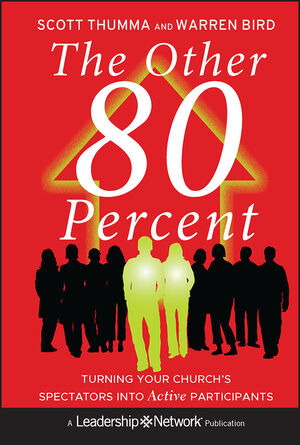The Other 80 Percent: Turning Your Church's Spectators into Active ParticipantsISBN: 978-0-470-89129-2
Hardcover
256 pages
May 2011, Jossey-Bass
 |
||||||
Connect with Wiley Publicity
The Other 80 Percent: Turning Your Church's Spectators into Active Participants
San Francisco, CA - The new book, "The Other 80 Percent: Turning Your Church's Spectators into Active Participants," by Scott Thumma and Warren Bird addresses the question of why there are so few active attenders and so many nominal Christians in the country. In essence, churches are just trading and recycling their disconnected members. Church leaders don't adequately reach out to disillusioned members or find ways that work to reconnect them in meaningful spiritual service. This steady flow out the backdoor, through dissatisfaction or death, is keeping most congregations stagnant or in decline.
This book uses a mix of original analysis of national research on attenders, field studies, interviews and reflection on the cultural shifts related to volunteering to deal directly with the 20/80 problem (20% of the people do 80% of the work while most of the rest do nothing). It suggests various strategies by which a church's leadership can address member mobilization and discipleship.
The premise of the book is that very few church leaders engage a large percentage of their membership in a life of faith that includes regular involvement in the congregation. This book confronts the too-often taken for granted reality that it is acceptable for a church to function with only half its members in attendance and a quarter significantly involving giving, serving, fellowshipping, attending, or inviting others.
To change this pattern leadership needs to listen to what their people say about why they are and aren't engaged. They must learn about larger contributing factors, including cultural and structural reasons, staff perceptions and church programs that keep members from being more involved.
The authors offer possible ways to lead a congregation past the 20/80 malaise. They suggest that leadership teams need to evaluate what they are currently doing as a church to facilitate involvement. They implore clergy, in desperate times like these for the future of the church, to think creatively and outside the usual approaches to reach the less-involved. There is no single solution, no one-size-fits-all answer, to this problem. However, the book does offer possible approaches to addressing this issue from which church leadership can pick and choose the most fitting approach for their context.



